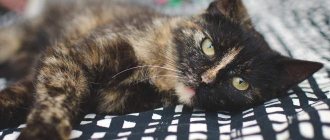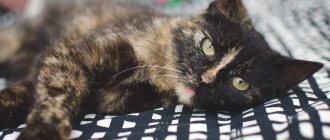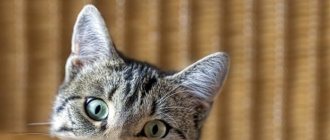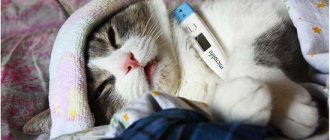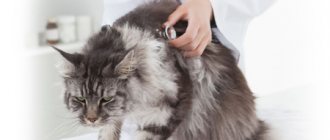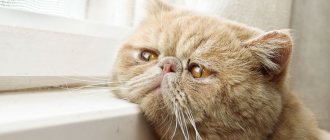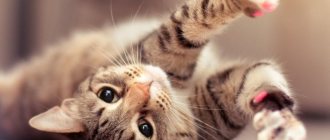If a cat's hind legs fail, this may indicate a traumatic injury, fibrocartilaginous embolism, stroke, spinal hernia, hyperparathyroidism, spinal cord inflammation, thromboembolism, a consequence of a tick bite, vitamin deficiency and metabolic disorders, hip dysplasia, cardiomyopathy. To find out the reason why the paws are failing, the owner should take the cat to the veterinarian. The doctor will diagnose and prescribe treatment.
According to veterinarian statistics, in 21% of cases, arterial thromboembolism with failure of the animal’s hind legs develops against the background of cardiomyopathy.
Reasons why a cat's legs can't walk
Back injury
Spinal injury and pinched nerves occur as a result of a fall from a height, a blow to the back and hind limbs with a heavy object, or a car injury. Most often, the vertebrae of the sacrolumbar region, where the sciatic nerve is located, are damaged. As a result of mechanical action, the bones are displaced and swelling occurs. In addition to the fact that the cat’s hind legs give way and are taken away, the following signs are observed:
- severe pain, especially if the animal moves;
- decreased or absent sensitivity and reflexes of the legs;
- anxiety;
- tachycardia;
- gait disturbance, the cat staggers and drags its paws.
Fibrous cartilaginous embolism
Fibrous cartilaginous embolism develops due to impaired blood supply to the spinal cord structures.
It is rare in cats and is characterized by closure of the spinal cord. Partial or complete cessation of blood supply to the spinal structures leads to cell dysfunction. The etiology of the disease is not clear. Fibrous-cartilaginous embolism begins acutely and suddenly, but the cat does not experience severe pain. The disease causes slight lameness or severe weakness of the hind legs, when the animal cannot stand up. Often the cat does not feel pain in the affected toes. The disease is characterized by uneven changes in the paws: the right side of the body may function worse than the left, and vice versa.
Consequence of stroke
The disease develops as a result of rupture of a vessel or blockage of the lumen by a thrombus. Because of this, the blood supply to the tissues is sharply disrupted and hypoxia occurs. The reason is stress, poisoning of various etiologies, hypertension, cardiovascular and kidney diseases, endocrine disorders, helminthiasis. Symptoms:
- their legs become weak, they don’t listen well, and their legs get twisted;
- coordination is impaired;
- unnatural head tilt;
- inappropriate behavior;
- decreased vision and appetite;
- uncontrolled urination and defecation;
- nystagmus;
- momentary fainting.
Herniated disc
Intervertebral hernia is accompanied by acute back pain and decreased sensitivity of the limbs.
If a cat's hind legs fail, this is a sign of protrusion of the vertebral nucleus and rupture of the fibrous ring. It develops in an old animal, as well as due to injuries, heavy physical exertion, or careless handling of the pet during play. Manifestation:
- severe back pain;
- the legs are very weak, they do not hold, they drag;
- the sensitivity of the hind limbs decreases.
Hyperparathyroidism
If a kitten's hind legs move apart, it cannot walk, drags its legs, collapses and falls, this indicates excessive production of parathyroid hormone by the thyroid gland. The cause is an imbalance of calcium and phosphorus due to improper diet. Paresis and deformation of the legs, impaired urination and defecation, growth retardation, and late change of teeth occur.
Spinal cord inflammation
Limb failure occurs due to spinal damage due to infectious diseases, poisoning, and traumatic back injuries. A pregnant cat that has purulent processes in the uterus can suffer. Signs:
- severe pain syndrome;
- hyperthermia;
- paralysis of the hind legs;
- hyperexcitability;
- licking and biting the back of the body.
Arterial thromboembolism
The formation of a blood clot triggers oxygen starvation, causing the animal to feel severe weakness in the legs.
When a cat stretches its hind legs, does not get up and falls, this indicates a blockage of the arteries with a blood clot. Impaired blood flow leads to oxygen starvation of tissues, which causes the cat's legs to hurt and collapse. The pathology occurs against the background of blood clotting disorders, neoplasms, decreased permeability of vascular walls, heart disease, and poisoning. Signs:
- changes in gait and the appearance of lameness;
- legs are cold and pale;
- severe muscle tension and soreness.
Tick bite
If one leg does not walk, the animal often squats, or the cat is paralyzed, this is a manifestation of an ixodid tick bite and the development of tick-borne encephalitis. In addition to the fact that the front or rear legs do not move, the disease is manifested by refusal of food, difficulty breathing, pallor of the mucous membranes, apathy, convulsions, changes in behavior and loss of coordination of movements.
Vitamin deficiency and potassium metabolism disorders
If a cat crouches and drags its hind paw when walking, this is a manifestation of a lack of vitamins B and D, which are necessary to strengthen bones, nerves, and muscle tissue. Potassium is needed for the transmission of nerve impulses, improving the functioning of the heart and kidneys. Veterinarians associate the etiology of vitamin deficiency and potassium deficiency with poor nutrition when the cat is malnourished or has helminths.
Hip dysplasia
The congenital disease leads to curvature of the pelvis, and in old age cats experience muscle weakness.
It is considered a congenital feline disease in which kittens are born with underdeveloped hip joints. In cats, due to weak ligaments, the paw does not function well, it drifts to the side when moving, and later paralysis, curvature of the pelvis, arthrosis of the hip joint, and habitual dislocation develop. An old cat develops muscle weakness, she is unable to lift her legs, drags them, and refuses to jump.
Cardiomyopathy
It is characterized by thickening of the walls and muscles of the heart, as a result of which the blood supply to all organs deteriorates. Often, against the background of cardiomyopathy, blood clots form that clog the blood vessels. Thromboembolism develops, due to which the hind limbs suffer and the cat falls on its hind paw.
Signs of limb failure
Cuts to the hind limbs in cats, as well as paralysis, have a fairly clear clinical picture. The owner may notice that the cat drags one or both hind legs, the gait becomes unsteady (shaky), and pain occurs when leaning on the hind leg and when walking.
When characteristic symptoms of paralysis of the hind limbs appear, the owner’s task is to take a close look at the general behavior of his pet.
The main signs of paresis or paralysis of the paws are:
- unsteady, unsteady gait affecting the back of the body;
- delay in making movements, loss of balance;
- weakness in the cat’s hind legs (the limbs may move apart, and after a while they fail);
- constant squatting on the hindquarters (not completely), as a rule, is observed in older animals;
- dragging of the hind limbs, which is characterized by not lifting them off the floor when walking;
- decreased overall mobility.
Any of the above symptoms indicates disorders in the musculoskeletal system and requires immediate diagnostic measures. There are many reasons that provoke a condition in which a cat’s hind legs become entangled.
Delay in diagnosis and self-medication only aggravate the animal’s condition, causing it significant discomfort and severe pain.
What to do if a cat loses its paws?
Therapy is prescribed by a veterinarian individually. For injuries and thromboembolism, surgical intervention is performed. Symptomatic treatment and antibiotics alleviate the condition of a stroke or after a tick bite. In case of a herniated spine, the protrusion is removed and the displaced structures are put in place. You should massage the cat's hind legs - stroking, flexing and extending the legs, kneading. Hyperparathyroidism is treated with calcium supplements, and for vitamin deficiency, a balanced diet is prescribed.
Causes of the disease
Rickets can develop as a result of disruption of various metabolic processes within bone tissue. The body's cells do not absorb calcium well, even if they receive it in sufficient quantities. As a result, the structure of the bone tissue is disrupted and it becomes softer. In other words, the skeleton practically softens. This leads to a change in the cat’s lifestyle and habits. Involuntary convulsions, weakness and other negative manifestations may occur. All this affects the cat’s behavior; he becomes less mobile, lethargic, and tired.
Rickets is usually observed in kittens between birth and 6 months . It is extremely rare for such a complex disease to occur in an adult animal. There are many different causes for the occurrence and development of the disease. common causes of rickets in cats can be identified
- Poor nutrition, imbalance of nutrients. Lack of vitamins and microelements necessary for the formation and development of bone tissue.
- Various chronic diseases that affect the absorption and metabolism of calcium in the body.
- Obesity, which can be caused by various reasons, including as a result of improper nutrition on the part of the owners.
There are cases when rickets is observed in animals that were fed various artificial mixtures. Therefore, if it is not possible to ensure normal feeding of the kitten, then it is better to use special mixtures as a replacement. Such mixtures contain everything necessary for the normal and full development of a cat, including calcium and vitamins in the required quantities.
It is important to understand the fact that the disease can develop not only with a lack of calcium. Often the cause of the disease may be the lack of other elements that promote calcium absorption. Often, kitten owners begin to try to treat them with various available remedies and traditional medicine. But you need to understand that this is a rather serious and complex disease, the treatment of which must be taken seriously. Therefore, if symptoms occur, you should immediately seek help from a doctor.
How is the treatment carried out?
Untreated injuries and inflammation can trigger chronic processes, leaving the cat disabled.
The treatment regimen is determined by the doctor based on the reasons why the cat presses its hind paw. Traumatic injuries are cured by applying a splint. In case of displaced closed fractures, the bone is fixed with an Ilizarov apparatus, and osteosynthesis is performed using knitting needles, medical bolts, and titanium plates. For inflammatory processes, antibiotics and physiotherapy with heat are prescribed. To restore cartilage tissue, it is recommended to add chondroitin, glucosamine and fish oil to the animal’s food. For stinging insect bites, corticosteroids are prescribed.
Diagnosis of the condition
If you notice one or more symptoms in your cat, do not hesitate to contact your veterinarian. The sooner you start treatment, the faster your pet will return to a healthy life. Diagnosis of the condition begins with an initial examination.
The specialist pays attention to the condition of the animal’s coat and the position of the hind limbs. A diagnosis can only be made after the veterinarian observes the cat in motion. Additionally, joints are palpated to identify:
- swelling,
- soreness,
- deformation.
The most common diagnostic method is radiographic examination. The resulting images will show changes in the articular tissue, indicating degenerative changes.
Prevention methods
Rickets develops in a cat as a result of improper feeding and if the animal does not receive enough useful elements, including calcium. The following preventive measures can be distinguished:
- The cat should receive adequate nutrition throughout the entire pregnancy. The same applies to the lactation period. It is necessary to know the daily norms of calcium and maintain the proportions of the elements.
- If possible, the cat should be released into sunlight.
- If during the first 10-12 days kittens feed on cat's milk, then the likelihood of rickets is minimal and practically excluded.
- The kitten should be provided with adequate physical activity. This is important for the development of bones and muscle tissue. In the process of games and physical activity, the kitten grows and develops.
Based on all of the above, we can conclude that the occurrence of rickets may be rather an exception. If you feed and care for your cat correctly, provide adequate nutrition, and monitor the nutrition and development of the kittens, then there will be no problems.
Treatment of arthritis and arthrosis
How to treat arthritis in a cat? The first and most important rule is do not self-medicate! Therapy of joint tissue diseases requires professionalism and experience, so entrust the treatment to qualified veterinarians in Moscow.
They will determine the cause of arthritis or arthrosis, and then select effective therapy aimed at eliminating it. Additionally, maintenance treatment is prescribed using chondroprotectors and non-steroidal anti-inflammatory drugs.
In addition to drug therapy, it is important to monitor your pet’s weight. If your cat is obese, be sure to put him on a low-calorie diet. This may include:
- lean meat,
- sea fish,
- low-fat fermented milk products,
- porridge on the water,
- boiled vegetables.
Don't forget about regular checkups at the veterinary clinic!
Associated symptoms
Symptoms appear depending on the pathology. Among the associated symptoms with middle ear diseases are the following aspects:
- profuse drooling;
- disturbance of movements when walking;
- difficulty eating;
- different pupil sizes;
- secretion of secretory fluid from the ears and eyes;
- inability to blink.
If the cause is a spinal injury, treatment is carried out using surgery under general anesthesia. To reduce the risk of additional injury during treatment, it is recommended to give the cat sedatives. If cancer is diagnosed, a biopsy test is required. Treatment usually involves supportive care to prevent progression of the disease. Problems with the motor activity of the hind legs can be the result of kidney or genital disease in females (endometritis is often diagnosed - inflammation of the mucous membrane or wall of the uterus). Due to pain, the cat begins to stretch its hind legs, squat and lower its tail to reduce symptoms. In this case, anti-inflammatory, painkillers and antibacterial drugs are indicated. For cancer, chemotherapy is prescribed.
It should be remembered that the lack of timely treatment can lead to irreversible consequences, even death. Therefore, it is very important to contact a specialist for advice when the first signs of paw pulling or squatting appear.
How does the disease manifest itself?
Owners need to have a clear understanding of how the disease manifests itself, how one can understand that it is rickets. The first serious indicator can be considered a kitten's developmental delay. If he grows slowly, weakly gains muscle mass, and is inactive, then this is already a serious indicator that something is going wrong. We can highlight the most striking symptoms that may indicate the development of rickets in a kitten:
- The ribs become flat and they put pressure on various internal organs.
- Joints thicken.
- The spine changes visually. It is clear that something is wrong with the animal.
- Crooked paws. As a result, the kitten may limp and experience various problems and discomfort.
- Teeth change slowly.
- Behavior changes. The kitten is less active than it should be.
These are the main symptoms and indicators that an animal may develop rickets. As soon as owners identify these problems, they should immediately seek advice from specialists. Only an experienced veterinarian will be able to identify the problem, carry out a series of diagnostic measures and help the animal. This can help not only improve the kitten’s condition, but in most cases save its life. The sooner owners turn to specialists for help, the greater the chance of helping their cat.
